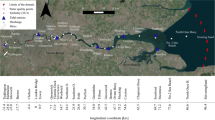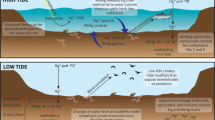Abstract
Heavy metal bioaccumulation models are important for interpreting water quality data, predicting bioaccumulation in organisms, and investigating the provenance of contaminants. To date they have been predominantly used as single-issue models, under steady-state conditions and in isolation of the biogeochemical processes that control metal bioaccumulation. Models that incorporate these processes would allow a more holistic approach to bioaccumulation modeling and contaminant assessment; however, this has been rarely undertaken, probably because it requires the integration of inter-disciplinary areas. In this study, we have developed such a model that integrates three key multi-disciplinary areas (biological, metal speciation, and bioaccumulation processes) and responds to variations in temporal external and internal forcing. Furthermore, spatial context is provided by developing the model within a simple hydrodynamic box-modeling framework. The calibrated model was able to predict with reasonable accuracy the temporal and spatial trends of soft-tissue copper bioaccumulation in a coastal oyster. This exploratory model was also used to highlight the importance of phytoplankton as an important vector of copper uptake dynamics by an oyster, therefore reinforcing the importance of the integrated approach. Finally, our model provides a framework for greater application beyond this specific example such as in the areas of waterway restoration, which has been shown to be an important area of ecological and environmental research.






Similar content being viewed by others
References
Arhonditsis GB, Papantou D, Zhang W, Perhar G, Massos E, Shi M. 2008. Bayesian calibration of mechanistic aquatic biogeochemical models and benefits for environmental management. J Marine Syst 73:8–30.
Bell S. Amghar M. 2001 Modeling scenarios for South East Queensland Regional Water Quality Management Strategy, Cooperative Research Centre for Coastal Zone, Estuary and Waterway Management. Technical Report 2.
Bowie GL, Mills WB, Porcella DB, Campbell CL, Pagenkopf JR, Rupp GL, Johnson KM, Chan PWH, Gherini SA, Chamberlain CE. 1985. Rates, constants, and kinetics formulations in surface water quality modeling. 2nd edn. Athens: Environmental Research Laboratory Office of Research and Development U.S. Environmental Protection Agency.
Brand LE, Sunda WG, Guillard RRL. 1986. Reduction of marine phytoplankton reproduction rates by copper and cadmium. J Exp Marine Biol Ecol 96:225–50.
Buffle J, De Vitre RR. 1993. Chemical and biological regulation of aquatic systems. Boca Raton: CRC Press.
Burton ED, Phillips IR, Hawker DW. 2004. Trace metals and nutrients in bottom sediments in the Southport Broadwater, Australia. Marine Pollut Bull 48:378–84.
Burton ED, Phillips IR, Hawker DW. 2005. Reactive sulfide relationships with trace metal extractability in sediments from southern Moreton Bay, Australia. Marine Pollut Bull 50:589–95.
Byrne RH, Miller WL. 1985. Copper(II) carbonate complexation in seawater. Geochim Cosmochim Acta 49:1837–44.
Casas S, Bacher C. 2006. Modeling trace metal (Hg and Pb) bioaccumulation in the Mediterranean mussel, Mytilus galloprovincialis, applied to environmental monitoring. J Sea Res 56:168–81.
Chang SI, Reinfelder JR. 2000. Bioaccumulation, subcellular distribution, and trophic transfer of copper in a coastal marine diatom. Environ Sci Technol 34:4931–5.
Chapra SC. 1997. Surface water quality modelling. New York: McGraw Hill. p 844.
Coale KH, Bruland KW. 1988. Copper complexation in the Northeast Pacific. Limnol Oceanogr 33:1084–101.
Conti ME, Cecchetti G. 2003. A biomonitoring study: trace metals in algae and mollusks from Tyrrhenian coastal areas. Environ Res 93:99–112.
Dennison WC, Abal E. 1999. Moreton Bay study: a scientific basis for the healthy waterways campaign. South East Queensland Regional Water Quality Management Strategy, Brisbane.
Di Toro DM, Allen HE, Bergman HL, Meyer JS, Paquin PR, Santore RC. 2000. The biotic ligand model: a computational approach for assessing the ecological effects of metals in aquatic systems. International Copper Association Ltd. Published as part of the Environmental Program in a series on Copper in the Environment and Health.
Dowd M. 1997. On predicting the growth of cultured bivalves. Ecol Model 140:113–31.
Dowd M. 2005. A bio-physical coastal ecosystem model for assessing environmental effects of marine bivalve aquaculture. Ecol Model 183:323–46.
Dzombak DA, Morel FMM. 1990. Surface complexation modelling: hydrous ferric oxide. New York: Wiley.
EHMP. 2008. Ecosystem Health Monitoring Program. www.healthywaterways.org.
Eisler R. 1998. Copper hazards to fish, wildlife and invertebrates: a synoptic review. USGS/BRD/BSR-1997-0002 Springfield: US Dept. of Commerce. pp 1–98.
Eyre BD, McKee LJ. 2002. Carbon, nitrogen, and phosphorus budgets for a shallow subtropical coastal embayment (Moreton Bay, Australia). Limnol Oceanogr 47:1043–55.
Gabric AJ, McEwan J, Bell PRF. 1998. Water quality and phytoplankton dynamics in Moreton Bay, south-eastern Queensland. I. Field Survey and satellite data. Mar Freshw Res 49:215–25.
González-Dávila M, Santana-Casiano JM, Perez-Pena J, Millero FJ. 1995. Binding of Cu(II) to the surface and exudates of the alga Dunaliella tertiolecta in seawater. Environ Sci Technol 29:289–301.
González-Dávila M, Santana-Casiano JM, Laglera LM. 2000. Copper adsorption in diatom cultures. Marine Chem 70:161–70.
Goulet RR, Krack S, Doyle PJ, Hare L, Vigneault B, McGeer JC. 2007. Dynamic multipathway modeling of Cd bioaccumulation in Daphnia magna using waterborne and dietborne exposures. Aquat Toxicol 81:117–25.
He M, Wang Z, Tang H. 2001. Modelling the ecological impact of heavy metals on aquatic ecosystems: a framework for the development of an ecological model. Sci Total Environ 266:291–8.
Hirose K. 1994. Conditional stability constants of metal complexes of organic ligands in sea water: past and present, and a simple coordination chemistry model. Anal Chim Acta 284:621–34.
Ihaka R, Gentleman R. 1996. R: a language for data analysis and graphics. J Comput Graph Stat 5:299–314.
Jackson JBC, Kirby MX, Berger WH, Bjorndal KA, Botsford LW, Bourque BJ, Bradbury RH, Cooke R, Erlandson J, Esters JA, Hughes TP, Kidwell S, Lange CB, Lenihan HS, Pandolfi JM, Peterson CH, Steneek RS, Tegner MJ, Warner RR. 2001. Historical overfishing and the recent collapse of coastal ecosystems. Science 293:629–38.
Kim E, Mason RP, Bergeron CM. 2008. A modeling study on methylmercury bioaccumulation and its controlling factors. Ecol Model 218:267–89.
Koelmans AA, van der Heijde A, Knijff LM, Aalderink RH. 2001. Integrated modelling of eutrophication and organic contaminant fate & effects in aquatic ecosystems. A review. Water Res 35:3517–36.
Lee RW, Rust W. 1997. Light attenuation in a shallow, turbid reservoir, Lake Houston Texas. US Geological Survey, Water Resources Investigation Report 97-4064.
Lee C-L, Chen H-Y, Chuang M-Y. 1996. Use of oyster, Crassostrea gigas, and ambient water to assess metal pollution status of the charting area, Taiwan, after the 1986 green oyster incident. Chemosphere 33(12):2505–32.
Liao C-M, Chen B-C, Lin M-C, Chen J-W. 2002. An optimal trace zinc biomonitor (Haliotis diversicolor supertexta) control system design in aquacultural ecosystems. Appl Math Model 24:27–43.
Lim P-E, Lee C-K, Din Z. 1998. The kinetics of bioaccumulation of zinc, copper, lead and cadmium by oysters (Crassostrea iredalai and C. belcheri) under tropical field conditions. Sci Total Environ 216:147–57.
Luoma SN, Rainbow PS. 2005. Why is metal bioaccumulation so variable? Biodynamics as a unifying concept. Environ Sci Technol 39(7):1921–31.
Martell AE, Motekaitis RJ. 1988. Determination and use of stability constants. New York: VCH.
McEwan J. 1996. A coupled hydrodynamic, transport and kinetic model of eutrophication processes in Moreton Bay, Queensland. Brisbane: Department of Chemical Engineering, University of Queensland.
Midorikawa T, Tanoue E. 1994. Detection of strong ligand for copper in sea water and determination of its stability constant. Anal Chim Acta 284:605–19.
Moffett JW, Brand LE, Croot PL, Barbeau KA. 1997. Cu speciation and cyanobacterial distribution in harbors subject to anthropogenic Cu inputs. Limnol Oceanogr 42:789–99.
Monte L, Brittain JE, Gallego E, Håkanson L, Hofman D, Jiménez A. 2009. MOIRA-PLUS: a decision support system for the management of complex fresh water ecosystems contaminated by radionuclides and heavy metals. Comput Geosci 35:880–96.
Morel F. 1983. Principles of aquatic chemistry. New York: Wiley.
Mubiana VK, Blust R. 2007. Effects of temperature on scope for growth and accumulation of Cd, Co, Cu and Pb by the marine bivalve Mytilus edulis. Marine Environ Res 63:219–35.
Murray AG, Parslow JS. 1999. Modelling of nutrient impacts in Port Phillip Bay—a semi-enclosed marine Australian ecosystem. Marine Freshw Res 50:597–611.
Paquin PR, Gorsuch JW, Apte S, Batley GE, Bowles KC, Campbell PGC, Delos CG, Di Toro DM, Dwyer RL, Galvez F, Gensemer RW, Goss GG, Hogstrand C, Janssen CR, McGeer JC, Naddy RB, Playle RC, Santore RC, Schneider U, Stubblefield WA, Wood CM, Wu KB. 2002. The biotic ligand model: a historical overview. Comp Biochem Physiol Part C 133:3–35.
Parkhurst, DL, Appelo, CAJ. 1999. User’s guide to PHREEQC (version 2)—a computer program for speciation, batch-reaction, one-dimensional transport, and inverse geochemical calculations. Water Resources Investigations Report 99-4259. US Department of Interior US Geological Survey, Denver, Colarado.
Parslow J, Hunter J, Davidson, A. 1999. Estuarine eutrophication models. Final Report Project E6 National River Health Program. Water Services Association of Australia, Melbourne, Australia. CSIRO Marine Research, Hobart Tasmania. Report No.12, LWRRDC Occasional Paper 19/99.
Paulson AJ, Kester DR. 1980. Copper(II) ion hydrolysis in aqueous solutions. J Solut Chem 9:269–77.
Phillips DJH. 1980. Quantitative aquatic biological indicators. London: Applied Science Publishers.
R Development Core Team. 2009. R: a language and environment for statistical computing. R Foundation for Statistical Computing, Vienna, Austria. ISBN 3-900051-07-0. URL: http://www.R-project.org.
Reinfelder JR, Wang W-X, Luoma SN, Fisher NS. 1997. Assimilation efficiencies and turnover rates of trace elements in marine bivalves: a comparison of oysters, clams and mussels. Marine Biol 129:443–52.
Richards R, Chaloupka M. 2009. Temperature-dependent bioaccumulation of copper in an estuarine oyster. Sci Total Environ 407:5901–6.
Robinson WA, Maher WA, Krikowa F, Nell JA, Hand R. 2005. The use of the oyster Saccostrea glomerata as a biomonitor of trace metal contamination: Intra-sample, local scale and temporal variability and its implication for biomonitoring. J Environ Monit 7:208–23.
Scanes P. 1996. ‘Oyster Watch’: monitoring trace metal and organochlorine concentrations in Sydney's coastal waters. Mar Pollut Bull 33:226–38.
Scott BD. 1978. Phytoplankton distribution and light attenuation in Port Hacking estuary. Aust J Marine Freshw Res 29:31–44.
Shigesada N, Okubo A. 1981. Analyses of the self-shading effect on algal vertical distribution in waters. J Math Biol 12:311–26.
Simon NS. 1989. Nitrogen cycling between sediment and the shallow-water column in the transition zone of the Potomac River and Estuary. II. The role of wind-driven resuspension and adsorbed ammonium. Estuar Coast Shelf Sci 28:531–47.
Steele JH. 1962. Environment control of photosynthesis in the sea. Limnol Oceanogr 7:137–50.
van der Lee J. 1998. Thermodynamic and mathematical concepts of CHESS. Technical Report Nr LHM/RD/98/39, Ecole des Mines de Paris, Fontainebleau, France.
Wang WX, Fisher NS, Luoma SN. 1996. Kinetic determinations of trace element bioaccumulation in the mussel Mytilus edulis. Marine Ecol Prog Ser 129:165–76.
White SL, Rainbow PS. 1985. On the metabolic requirements for copper and zinc in molluscs and crustaceans. Marine Environ Res 16:215–29.
Acknowledgments
We thank the CRC for Coastal Zone Estuary and Waterway Management for providing financial assistance. We are also grateful to the Ecosystem Health Monitoring Program (EHMP) project team for their help in providing access to EHMP water quality data. Finally we thank the comments of two anonymous reviewers who significantly strengthened this manuscript.
Author information
Authors and Affiliations
Corresponding author
Additional information
Author Contributions
RGR conceived and designed study, performed research, analyzed data, contributed model and wrote the paper. MC conceived and designed study, performed research, analyzed data, contributed model and wrote the paper. RT performed research, analyzed data and assisted in writing the paper.
Rights and permissions
About this article
Cite this article
Richards, R.G., Chaloupka, M. & Tomlinson, R. Towards an Integrated Ecosystem-Based Bioaccumulation and Metal Speciation Model. Ecosystems 13, 1303–1318 (2010). https://doi.org/10.1007/s10021-010-9392-8
Received:
Accepted:
Published:
Issue Date:
DOI: https://doi.org/10.1007/s10021-010-9392-8




